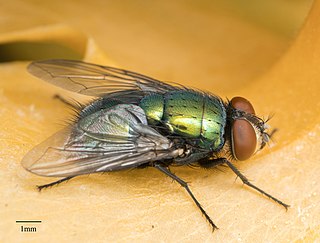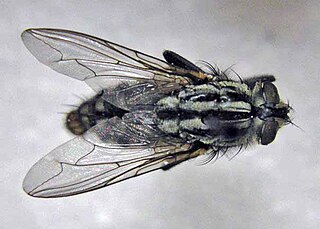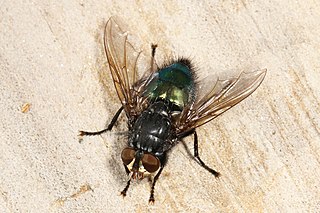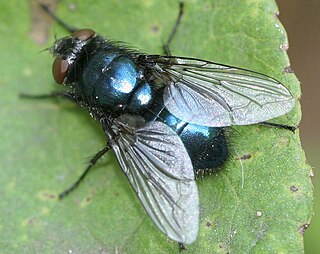Related Research Articles

Forensic entomology is the scientific study of the colonization of a dead body by arthropods. This includes the study of insect types commonly associated with cadavers, their respective life cycles, their ecological presences in a given environment, as well as the changes in insect assemblage with the progression of decomposition. Insect succession patterns are identified based on the time a given species of insect spends in a given developmental stage, and how many generations have been produced since the insects introduction to a given food source. Insect development alongside environmental data such as temperature and vapor density, can be used to estimate the time since death, due to the fact that flying insects are attracted to a body immediately after death. The identification of postmortem interval to aid in death investigations is the primary scope of this scientific field. However, forensic entomology is not limited to homicides, it has also been used in cases of neglect and abuse, in toxicology contexts to detect the presence of drugs, and in dry shelf food contamination incidents. Equally, insect assemblages present on a body, can be used to approximate a given location, as certain insects may be unique to certain areas. Therefore, forensic entomology can be divided into three subfields: urban, stored-product and medico-legal/medico-criminal entomology.

A maggot is the larva of a fly ; it is applied in particular to the larvae of Brachycera flies, such as houseflies, cheese flies, and blowflies, rather than larvae of the Nematocera, such as mosquitoes and crane flies.

The Calliphoridae are a family of insects in the order Diptera, with almost 1,900 known species. The maggot larvae, often used as fishing bait, are known as gentles. The family is known to be polyphyletic, but much remains disputed regarding proper treatment of the constituent taxa, some of which are occasionally accorded family status.

Myiasis, also known as flystrike or fly strike, is the parasitic infestation of the body of a live animal by fly larvae (maggots) that grow inside the host while feeding on its tissue. Although flies are most commonly attracted to open wounds and urine- or feces-soaked fur, some species can create an infestation even on unbroken skin and have been known to use moist soil and non-myiatic flies as vector agents for their parasitic larvae.

The common green bottle fly is a blowfly found in most areas of the world and is the most well-known of the numerous green bottle fly species. Its body is 10–14 mm (0.39–0.55 in) in length – slightly larger than a house fly – and has brilliant, metallic, blue-green or golden coloration with black markings. It has short, sparse, black bristles (setae) and three cross-grooves on the thorax. The wings are clear with light brown veins, and the legs and antennae are black. The larvae of the fly may be used for maggot therapy, are commonly used in forensic entomology, and can be the cause of myiasis in livestock and pets. The common green bottle fly emerges in the spring for mating.

Calliphora vomitoria, known as the blue bottle fly, orange-bearded blue bottle, or bottlebee is a species of blow fly, a species in the family Calliphoridae. Calliphora vomitoria is the type species of the genus Calliphora. It is common throughout many continents including Europe, Americas, and Africa. They are fairly large flies, nearly twice the size of the housefly, with a metallic blue abdomen and long orange setae on the gena.

Chrysomya rufifacies is a species belonging to the blow fly family, Calliphoridae, and is most significant in the field of forensic entomology due to its use in establishing or altering post mortem intervals. The common name for the species is the hairy maggot blow fly, and it belongs to the genus Chrysomya, which is commonly referred to as the Old World screwworms. This genus includes other species such as Chrysomya putoria and Chrysomya bezziana, which are agents of myiasis. C. rufifacies prefers very warm weather and has a relatively short lifecycle. It is widely distributed geographically and prefers to colonize large carcasses over small ones. The species commonly has a greenish metallic appearance and is important medically, economically, and forensically.
Forensic entomological decomposition is how insects decompose and what that means for timing and information in criminal investigations. Medicolegal entomology is a branch of forensic entomology that applies the study of insects to criminal investigations, and is commonly used in death investigations for estimating the post-mortem interval (PMI). One method of obtaining this estimate uses the time and pattern of arthropod colonization. This method will provide an estimation of the period of insect activity, which may or may not correlate exactly with the time of death. While insect successional data may not provide as accurate an estimate during the early stages of decomposition as developmental data, it is applicable for later decompositional stages and can be accurate for periods up to a few years.

Lucilia illustris is a member of the fly family Calliphoridae, commonly known as a blow fly. Along with several other species, L. illustris is commonly referred to as a green bottle fly. Lucilia illustris is typically 6–9 mm in length and has a metallic blue-green thorax. The larvae develop in three instars, each with unique developmental properties. The adult fly typically will feed on flowers, but the females need some sort of carrion protein in order to breed and lay eggs.

Phormia regina, the black blow fly, belongs to the blow fly family Calliphoridae and was first described by Johann Wilhelm Meigen.
In forensic entomology, entomotoxicology is the analysis of toxins in arthropods that feed on carrion. Using arthropods in a corpse or at a crime scene, investigators can determine whether toxins were present in a body at the time of death. This technique is a major advance in forensics; previously, such determinations were impossible in the case of severely decomposed bodies devoid of intoxicated tissue and bodily fluids. Ongoing research into the effects of toxins on arthropod development has also allowed better estimations of postmortem intervals.

The common toad fly, Lucilia silvarum, is a member of the fly family Calliphoridae. This fly was first discovered by Johann Wilhelm Meigen in 1826 and is found most notably in European and Western Countries.

Sarcophaga pernix, also known as the red-tailed flesh fly, is a fly in the Sarcophagidae family. This fly often breeds in carrion and feces, making it a possible vector for disease. The larvae of this species can cause myiasis, as well as accidental myiasis. It is potentially useful in forensic entomology.
Lucilia thatuna belongs to the family Calliphoridae, the species most commonly referred to as the blowflies, and the genus Lucilia. Along with several other species of Lucilia, L. thatuna is commonly referred to as a green bottle fly. L. thatuna is very scarce and not much is known about this particular fly. It has been noted to reside in mountainous regions of the northwestern United States.

Lucilia cuprina, formerly named Phaenicia cuprina, the Australian sheep blowfly is a blow fly in the family Calliphoridae. It causes the condition known as "sheep strike"'. The female fly locates a sheep with ideal conditions, such as an open wound or a build-up of faeces or urine in the wool, in which she lays her eggs. The emerging larvae cause large lesions on the sheep, which may prove to be fatal.

Cynomya cadaverina, also known as the shiny blue bottle fly, is a member of the family Calliphoridae, which includes blow flies as well as bottle flies. In recent years, this family has become a forensically important facet in many medicocriminal investigations in the growing field of forensic entomology. C. cadaverina is specifically important in determining a post-mortem interval, as well as other important factors.

Muscina is a genus of flies that belongs to the family Muscidae, currently consisting of 27 species. They are worldwide in distribution and are frequently found in livestock facilities and outside restrooms. The most common species are M. stabulans, M. levida, and M. prolapsa. Muscina flies commonly breed in manure and defecate on food, which has been linked to the spread of some disease and illnesses. The occurrence of Muscina larvae on dead bodies has led to their regular use in forensic investigations, as they may be used to estimate the time of death. Research have shown the prevalence of certain species of Muscina flies as vectors of diseases such as poliomyelitis.

Calliphora livida is a member of the family Calliphoridae, the blow flies. This large family includes the genus Calliphora, the "blue bottle flies". This genus is important in the field of forensic entomology because of its value in post-mortem interval estimation.

Lucilia coeruleiviridis, formerly Phaenecia coeruleiviridis, is commonly known as a green bottle fly, because of its metallic blue-green thorax and abdomen. L. coeruleiviridis was first discovered by French entomologist Pierre-Justin-Marie Macquart in 1855. It belongs to the family Calliphoridae and is one of many forensically important Diptera, as it is often found on decaying substances. L. coeruleiviridis is one of the most ubiquitous blow fly species in the southeastern United States, particularly in the spring and fall months.

Protophormia terraenovae is commonly called northern blowfly, blue-bottle fly or blue-assed fly. It is distinguished by its deep blue coloration and large size and is an important species throughout the Northern Hemisphere. This fly is notable for its economic effect as a myiasis pest of livestock and its antibiotic benefits in maggot therapy. Also of interest is P. terraenovae’s importance in forensic investigations: because of their temperature-dependent development and their prominent presence on corpses, the larvae of this species are useful in minimum post-mortem interval (mPMI) determination.
References
- ↑ Catts, E P; Goff, M L (1992-01-01). "Forensic Entomology in Criminal Investigations". Annual Review of Entomology. 37 (1): 253–272. doi:10.1146/annurev.en.37.010192.001345. ISSN 0066-4170. PMID 1539937. S2CID 37652159.
- ↑ "abuse." Dictionary.com Unabridged (v 1.1). Random House, Inc. 21 Mar. 2008. <Dictionary.com http://dictionary.reference.com/browse/abuse
- ↑ "neglect." The American Heritage Dictionary of the English Language, Fourth Edition. Houghton Mifflin Company, 2004. 21 Mar. 2008. <Dictionary.com http://dictionary.reference.com/browse/neglect>.
- 1 2 Gennard DE. Forensic Entomology: An Introduction. Wiley & Sons Ltd. 2007;1:13-14.
- ↑ Sherman RA, Hall MJR, Thomas S. Medicinal Maggots: An Ancient Remedy for Some Contemporary Afflictions. Annu Rev Entomol. 2000;45:55–81.
- ↑ Guerrini VH. Ammonia Toxicity and Alkalosis in Sheep Infested by Lucilia cuprina Larvae. Int J Parasitol. 1988;18:79–81.
- ↑ Benecke, Mark; Lessig, Rüdiger (2001). "Child neglect and forensic entomology". Forensic Science International. 120 (1–2): 155–159. doi:10.1016/S0379-0738(01)00424-8. PMID 11457624.
- ↑ Catts, E P; Goff, M L (1992-01-01). "Forensic Entomology in Criminal Investigations". Annual Review of Entomology. 37 (1): 253–272. doi:10.1146/annurev.en.37.010192.001345. ISSN 0066-4170. PMID 1539937. S2CID 37652159.
- ↑ "Child Abuse Prevention and Treatment Act." Administration for Children and Families. 10 FEB 2006. U.S. Department of Health and Human Services. 21 Mar 2008 <http://www.acf.hhs.gov/programs/cb/laws_policies/cblaws/capta/index.htm Archived 2008-03-30 at the Wayback Machine >
- 1 2 Spitz WU. Medicolegal Investigation of Death. 4th ed. Springfield: Charles C Thomas Ltd, 2004; 8:357-363.
- ↑ Benecke, Mark, Rüdiger Lessig. "Child Neglect and Forensic Entomology Archived 2011-07-07 at the Wayback Machine ." Forensic Science International 155-9(2001): 120 ff.
- 1 2 Elder Abuse and Neglect. Molly Hofer. 2008. http://www.urbanext.uiuc.edu/elderabuse/signs.html.
- ↑ Nursing Home Abuse. Goldberg, Persky, and White. 2004. 5 May 2007 http://www.elderly-abuse.com.
- 1 2 3 Benecke, Mark. "Neglect of the elderly: forensic entomology cases and considerations." Forensic Science International 146S (2004): S195-S199.
- ↑ James MT. The Flies That Cause Myiasis in Man. Miscellaneous Publication #631, Washington, D.C.: US Department of Agriculture, 1947.
- 1 2 Anderson, Gail. "Myiasis in pet animals in British Columbia: The potential of forensic entomology for determining duration of possible neglect." Canadian Veterinary Journal 45(2004): 993-998.
- ↑ Wall R, French N, Morgan K. Blowfly Species Composition in Sheep Myiasis in Britain. Med Vet Entomol. 1992;6:177–178.
- ↑ Wall R, French NP, Morgan KL. Population Suppression for Control of the Blowfly Lucilia sericata and Sheep Blowfly Strike. Ecol Entomol. 1995;20:91–97.
- ↑ Hall MJ. Traumatic Myiasis of Sheep in Europe: a review. Parasitologia. 1997;139:409–413.
- ↑ Greenberg B. Forensic entomology: case studies. Bull Entomol Soc Am. 1985;31:25–28.
- ↑ Lord WD, Catts EP, Scarboro DA, Hadfield DB. The green blowfly, Lucilia illustris (Meigen), as an indicator of human post-mortem interval: a case of homicide from Fort Lewis, Washington. Bull Soc Vector Ecol. 1986;11:271–275.
- ↑ Anderson GS. Insect succession on carrion and its relationship to determining time of death. In: Byrd JH, Castner JL, eds. Forensic Entomology. The Utility of Arthropods in Legal Investigations. Boca Raton: CRC Pr 2001:143–175.
- ↑ Anderson GS. The Use of Insects in Death Investigations: An Analysis of Forensic Entomology Cases in British Columbia Over A Five Year Period. Can Soc Forensic Sci J. 1995;28:277–292.
- ↑ Anderson GS. Wildlife forensic entomology: determining time of death in two illegally killed black bear cubs, a case report. J Forensic Sci. 1999;44:856–859. [PubMed]
- ↑ Merck, Melinda D. (2013). Veterinary Forensics: Animal Cruelty Investigations (2nd ed.). John Wiley & Sons, Inc. p. 276. ISBN 978-0-470-96162-9.